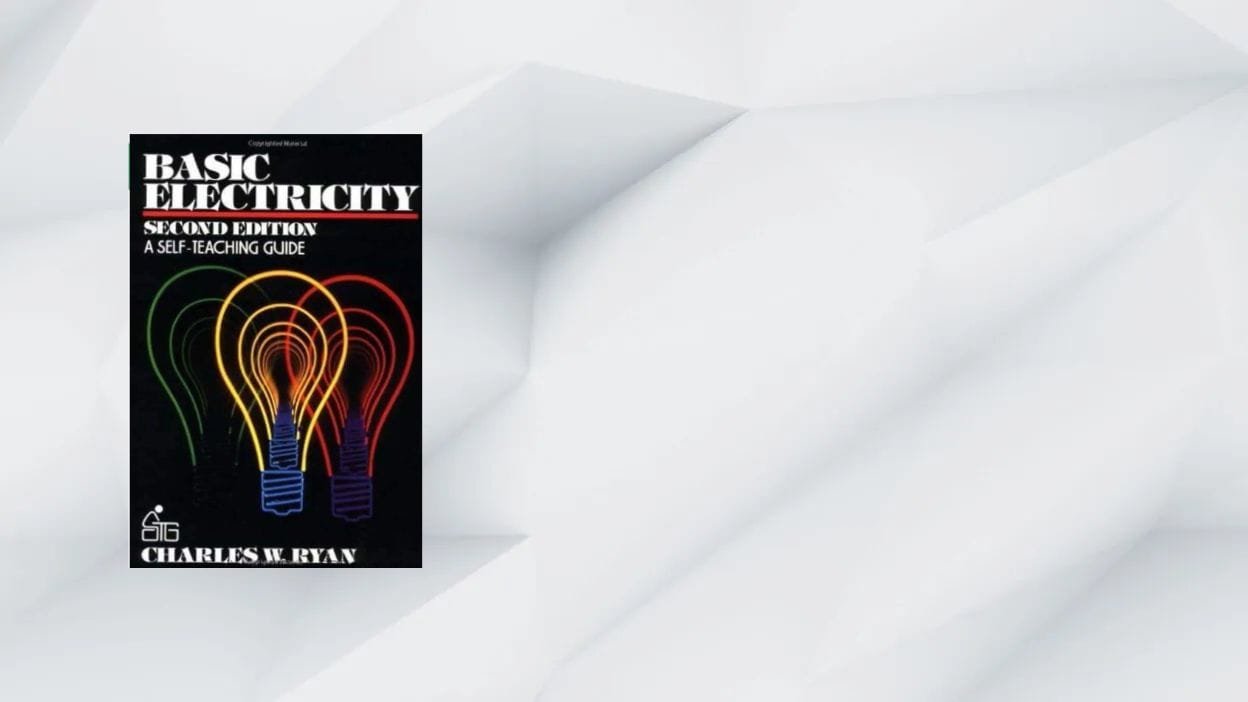If you’ve ever wondered what makes a light bulb glow or why your car battery behaves the way it does, Charles W. Ryan’s Basic Electricity 2nd Edition has your answers. First published by Wiley Press in October 1986, this 304-page self-teaching guide distils voltage, current, resistance and beyond into clear, step-by-step lessons—complete with self-tests and an end-of-course exam for hands-on reinforcement.
Book at a Glance
| Full Title | Basic Electricity: A Self-Teaching Guide (2nd Edition) |
| Author | Charles W. Ryan |
| Publisher / Year | Wiley Press • October 1986 |
| Length | 304 pages (trade paperback) |
| ISBN-13 | 978-0471850854 |
| Formats | Paperback & eBook |
| Typical Price | List $\approx,$US $21.95$; used $\approx,$US $9–15$ |
| Audience | Undergraduates, hobbyists, maintenance techs, self-learners |
Why Basic Electricity 2nd Edition Matters
- True self-teaching format – Each concept is introduced with plain-English explanations, illustrated examples and step-by-step problem solving that builds confidence without an instructor.
- Balanced theory & practice – From Ohm’s Law through AC circuit analysis, every derivation is followed by worked examples and self-tests, reinforcing understanding in real time.
- Updated 1980s tech – This edition adds coverage of then-new semiconductor devices and updated safety practices—bridging classic fundamentals with modern insights.
- End-of-course exam – A comprehensive exam at the back ties together all chapters, perfect for gauging your grasp before moving on to advanced texts.
Chapter Highlights
| Chapter(s) | Focus | Take-Away Skill |
|---|---|---|
| 1 | What Is Electricity? Voltage, current & resistance basics | Translate physical circuits into Ohm’s Law equations |
| 2 | Simple Circuits | Build and analyze single-loop and multi-loop DC circuits |
| 3 | Series & Parallel | Compare current flow and voltage drops in networked resistors |
| 4 | DC Compound Circuits | Tackle mixed series-parallel networks step by step |
| 5 | Magnetism & Electromagnets | Link magnetic fields to current flow for motor starters |
| 6 | AC Electricity Intro | Understand sine waves, frequency and effective values |
| 7 | Inductance & Capacitance | Calculate reactance and apply to tuned circuits |
| 8 | AC Circuit Theory | Analyze RLC circuits, impedance and power factor |
| Appendices | Reference tables & formula sheets | Quick-lookup for constants, unit conversions & answers |
Strengths
- Clarity & accessibility – Ryan’s conversational tone demystifies intimidating concepts for readers with high-school algebra only.
- Practical examples – Dozens of worked problems show exactly how to apply formulas—ideal for both classroom and bench-top study.
- Self-assessment tools – End-of-chapter quizzes and a full exam help learners identify gaps before they advance.
- Portable primer – At just 304 pages, it fits comfortably in a backpack or workshop reference binder.
Limitations
| Limitation | Impact | Quick Fix |
|---|---|---|
| Pre-2000 technology | Lacks deep coverage of modern power electronics (e.g., MOSFET drivers) | Supplement with a current electronics text or vendor app notes |
| Minimal circuit simulation | No SPICE/MATLAB guidance for virtual prototyping | Apply the worked examples to your simulator of choice |
| Basic visuals | Black-and-white schematics only | Redraw diagrams in color or use online interactive tools |
Comparison with Similar Guides
| Feature | Ryan (1986) | Electricity (Morrison, 2003) | Principles of Electric Circuits (Nilsson & Riedel, 2019) |
|---|---|---|---|
| Pages | 304 | 368 | 992 |
| Self-tests | ✔ | ✖ | ✖ |
| Updated tech | 1980s-era semiconductors | Early-2000s | Modern power electronics |
| Ideal for | Quick fundamentals | Broad theory recap | In-depth academic study |
FAQ
Is Basic Electricity 2nd Edition beginner-friendly?
Yes—Ryan assumes only high-school algebra and builds concepts from scratch with plenty of examples .
Does it include answers?
Odd-numbered problems and end-of-chapter quizzes have answers; the appendices provide formula sheets for self-study.
Where can I buy it?
Available new from Wiley’s site and retailers (ISBN 9780471850854); used copies on ThriftBooks start around US $9.29.
Can I use it with SPICE?
Absolutely—transcribe the worked examples into any SPICE-compatible simulator to verify results and experiment.

